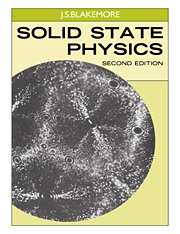Book contents
- Frontmatter
- Contents
- Preface
- General references
- Chapter One CRYSTALLINITY AND THE FORM OF SOLIDS
- Chapter Two LATTICE DYNAMICS
- Chapter Three ELECTRONS IN METALS
- Chapter Four SEMICONDUCTORS
- Chapter Five DIELECTRIC AND MAGNETIC PROPERTIES OF SOLIDS
- TABLE OF SOME USEFUL NUMERICAL CONSTANTS
- AUTHOR INDEX
- SUBJECT INDEX
Chapter Four - SEMICONDUCTORS
Published online by Cambridge University Press: 05 June 2012
- Frontmatter
- Contents
- Preface
- General references
- Chapter One CRYSTALLINITY AND THE FORM OF SOLIDS
- Chapter Two LATTICE DYNAMICS
- Chapter Three ELECTRONS IN METALS
- Chapter Four SEMICONDUCTORS
- Chapter Five DIELECTRIC AND MAGNETIC PROPERTIES OF SOLIDS
- TABLE OF SOME USEFUL NUMERICAL CONSTANTS
- AUTHOR INDEX
- SUBJECT INDEX
Summary
It was not feasible to discuss metals in Chapter 3 without mention of the companion topic of electronic conduction in insulating and semiconducting materials on several occasions. Now it is time to consider these solids in some detail.
For a metal, it is possible to vary the mobility of charge carriers (by changing the temperature to change the density and spectrum of phonons, or by changing the density of defects in the crystal), but the number of charge carriers is fixed. This number of free electrons may be characterized by a fixed electrochemical potential (Fermi energy) or in terms of some other suitable invariant parameter, and most investigative techniques with metals tell us only about the properties of electrons at the Fermi energy.
Things are very different in a semiconductor. The numbers (as well as the mobilities) of charge carriers depend on temperature and on the presence of defects or impurities. At thermodynamic equilibrium it is possible to express the occupancy of all electron states at all energies in terms of a single normalizing parameter or Fermi level, but this Fermi level is a consequence of the overall electrostatic balance and does not have to coincide with the energy of any mobile electrons. Thus in a semiconductor, we have to evaluate the dependence of the Fermi level on temperature and flaw concentration.
- Type
- Chapter
- Information
- Solid State Physics , pp. 293 - 404Publisher: Cambridge University PressPrint publication year: 1985
- 1
- Cited by



